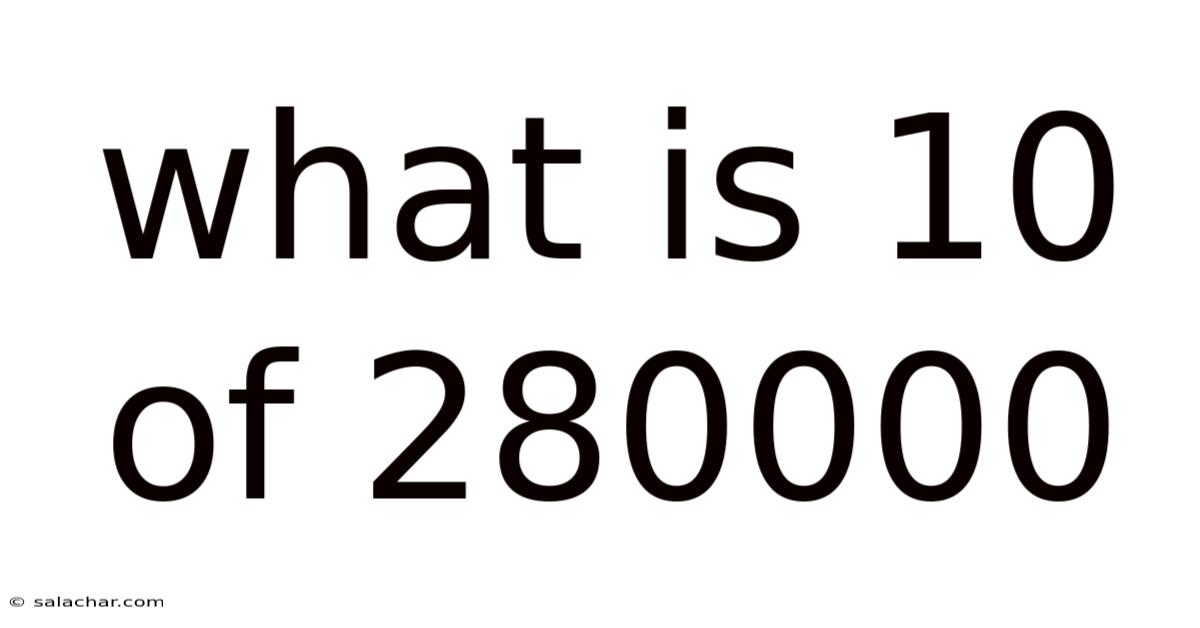What Is 10 Of 280000
salachar
Sep 15, 2025 · 4 min read

Table of Contents
What is 10% of 280,000? A Deep Dive into Percentages and Their Applications
Finding 10% of 280,000 might seem like a simple arithmetic problem, but it's a gateway to understanding percentages – a fundamental concept in mathematics with widespread applications in finance, business, science, and everyday life. This article will not only solve this specific problem but also explore the underlying principles, different calculation methods, and practical examples to solidify your understanding of percentages.
Introduction: Understanding Percentages
A percentage is a way of expressing a number as a fraction of 100. The word "percent" comes from the Latin "per centum," meaning "out of a hundred." Therefore, 10% means 10 out of every 100, or 10/100, which simplifies to 1/10. Understanding this fundamental relationship is key to solving percentage problems.
Method 1: The Direct Calculation Method
The most straightforward way to find 10% of 280,000 is to convert the percentage to a decimal and multiply. Since 10% is equivalent to 0.10 (10 divided by 100), the calculation is:
0.10 * 280,000 = 28,000
Therefore, 10% of 280,000 is 28,000.
Method 2: The Fraction Method
As mentioned earlier, 10% is equivalent to the fraction 1/10. This allows us to solve the problem using division:
280,000 / 10 = 28,000
This method is particularly useful when dealing with percentages that have simple fractional equivalents, such as 25% (1/4), 50% (1/2), and 75% (3/4).
Method 3: The Proportion Method
This method is useful for solving more complex percentage problems. We can set up a proportion:
10/100 = x/280,000
Where 'x' represents the unknown value (10% of 280,000). To solve for x, we cross-multiply:
10 * 280,000 = 100 * x
2,800,000 = 100x
x = 2,800,000 / 100
x = 28,000
Again, we find that 10% of 280,000 is 28,000.
Practical Applications of Percentage Calculations
Understanding percentage calculations is crucial in various real-world scenarios:
-
Finance: Calculating interest on loans, savings accounts, and investments. For example, if you have a savings account with a 10% annual interest rate and $280,000 in your account, you would earn $28,000 in interest after one year.
-
Sales and Discounts: Determining the final price of an item after a discount. A 10% discount on a $280,000 property would mean a reduction of $28,000.
-
Taxes: Calculating income tax, sales tax, or property tax. If the property tax rate is 10%, a property valued at $280,000 would incur a $28,000 tax.
-
Statistics: Representing data in a clear and concise manner. Percentages are frequently used to show proportions in graphs, charts, and reports. For instance, if 10% of a survey population chose a particular option, it means that out of 280,000 respondents, 28,000 chose that option.
-
Science: Expressing the concentration of solutions or the efficiency of processes. For example, a 10% saline solution means 10 grams of salt dissolved in 100ml of water.
Beyond the Basics: Calculating Other Percentages
While we've focused on calculating 10%, the principles can be applied to finding any percentage of a number. For instance, to find 15% of 280,000, we would calculate:
0.15 * 280,000 = 42,000
Or, using the fraction method (approximating 15% as 3/20):
280,000 / 20 * 3 = 42,000
Understanding Percentage Increase and Decrease
Percentages are also used to represent increases or decreases in values. For example:
-
Percentage Increase: If a value increases from 200,000 to 280,000, the percentage increase is calculated as follows:
(Increase/Original Value) * 100% = ((280,000 - 200,000)/200,000) * 100% = 40%
-
Percentage Decrease: If a value decreases from 280,000 to 252,000, the percentage decrease is calculated as follows:
(Decrease/Original Value) * 100% = ((280,000 - 252,000)/280,000) * 100% = 10%
Frequently Asked Questions (FAQ)
-
Q: What if I need to find a percentage that isn't a whole number, like 7.5%?
A: Simply convert the percentage to its decimal equivalent (0.075) and multiply by the number. 0.075 * 280,000 = 21,000.
-
Q: How can I calculate the percentage one number represents of another?
A: Divide the smaller number by the larger number and multiply by 100%. For example, to find what percentage 28,000 is of 280,000, you would calculate (28,000 / 280,000) * 100% = 10%.
-
Q: Are there any online calculators or tools to help with percentage calculations?
A: Yes, many free online percentage calculators are available that can perform various percentage calculations quickly and easily. These are particularly useful for more complex calculations.
Conclusion: Mastering Percentage Calculations
Finding 10% of 280,000, while seemingly simple, opens the door to a deeper understanding of percentages and their vast applications. Mastering these calculations is essential for success in various fields, from personal finance to advanced scientific studies. By understanding the different calculation methods and their applications, you'll be well-equipped to tackle various percentage problems with confidence. Remember to practice regularly and apply these concepts to real-world scenarios to truly solidify your knowledge. The ability to effortlessly calculate percentages is a valuable skill that will serve you well throughout your life.
Latest Posts
Latest Posts
-
At Least Means In Math
Sep 15, 2025
-
Volume Of Hexagonal Unit Cell
Sep 15, 2025
-
Calcium Carbonate Reaction With Water
Sep 15, 2025
-
What Is 160 In Kg
Sep 15, 2025
-
Molar Mass Of Ammonium Sulfite
Sep 15, 2025
Related Post
Thank you for visiting our website which covers about What Is 10 Of 280000 . We hope the information provided has been useful to you. Feel free to contact us if you have any questions or need further assistance. See you next time and don't miss to bookmark.